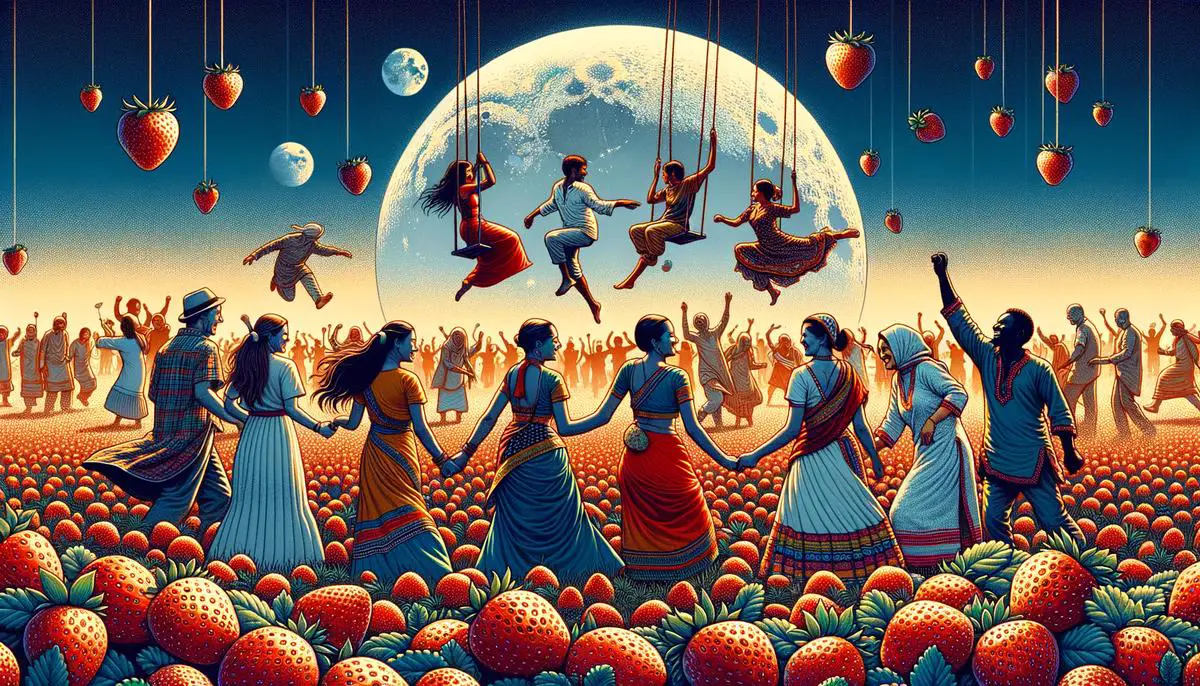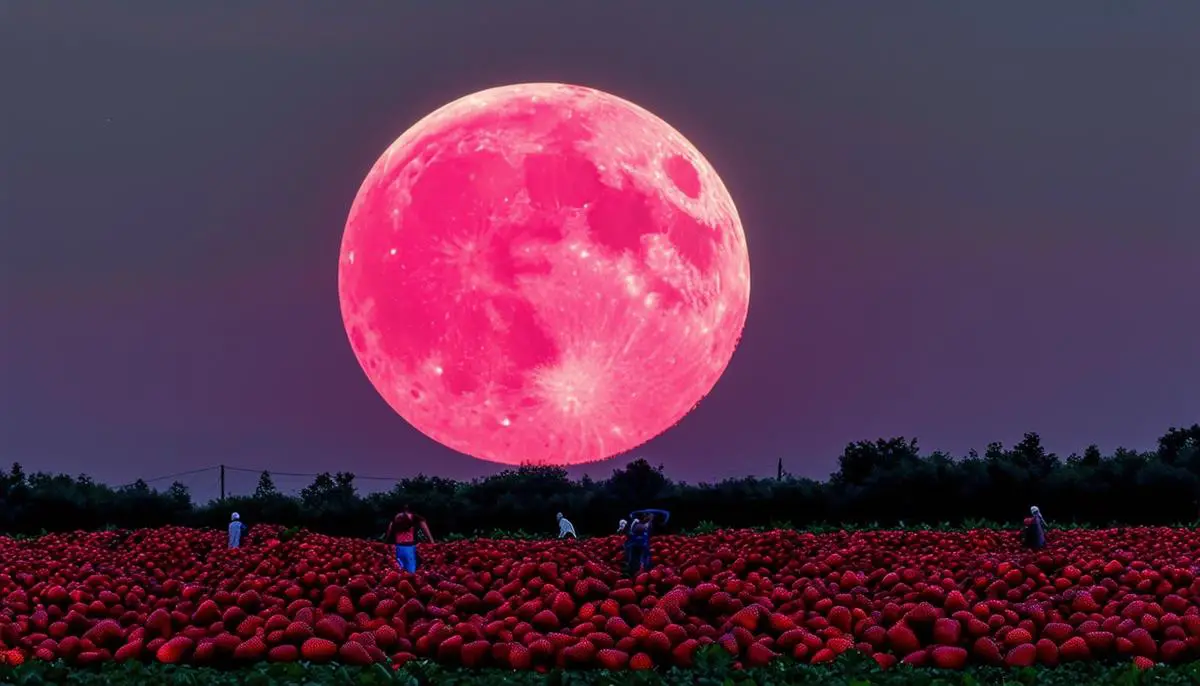The Strawberry Moon, with its rich cultural, spiritual, and astronomical significance, offers a unique glimpse into how different societies have celebrated and interpreted this celestial event. From Native American tribes to European traditions, the June full moon has been a marker of time, a symbol of growth, and a beacon of shared human experience.
Historical Roots and Folklore
Native American tribes hold the Strawberry Moon in high regard. For the Algonquin and others in the northeastern U.S., it marks the strawberry harvest—eagerly awaited, but brief. The moon signals high summer, when the wild strawberries are ready for picking.
The Haida tribe calls it the Berries Ripen Moon, reflecting this period of blossoming and bounty. Similarly, the Lakota tribe also associates the June full moon with ripening berries, emphasizing nature's cycles.
European cultures have their own interpretations. There's the Honey Moon, coinciding with traditional June weddings and honeymoons. Named after Juno, the Roman goddess of marriage, the month itself underscores the Moon's ties to love and commitment. Mead Moon is another term, reflecting old customs of mead-making for newlyweds to ensure happiness.
In Sri Lanka, Poson Poya commemorates the arrival of Buddhism, linking the moon to spiritual enlightenment. These events elevate the moon beyond a mere timekeeper to a beacon of cultural and spiritual unity.
Colonial America adopted many Native American names. The Pink Moon in April and the Strawberry Moon in June were especially popular. These names helped settlers sync their activities with the natural cycles, fostering a deeper connection to the land.
Names for June's full moon also include:
- Rose Moon
- Hot Moon
The English and Germans favored these terms, linking them to peak rose bloom and the onset of summer heat. Each moniker brings a layer of cultural richness, reflecting local geography and customs.
Occultations add a celestial twist. The moon occasionally eclipses stars like Antares, the heart of Scorpius, making its cultural and spiritual significance even more profound. When the June full moon aligns with such stars, it's an added spectacle.
This blend of history and folklore around the Strawberry Moon offers a rich mix of human tradition. From strawberries to mead, marriage to spirituality, it unites diverse cultures under one luminous orb.

Spiritual and Symbolic Meanings
In the light of the Strawberry Moon, spiritual and symbolic meanings abound, inviting us to explore personal growth, fertility, and transformation. This full moon is not just a celestial event; it's a time saturated with potential for deep introspection and energetic shifts.
As June ushers in the Summer Solstice, the Strawberry Moon serves as a celestial marker signaling a period ripe for new beginnings and personal evolution. The energy of this moon is a unique blend of vitality and introspection. It's a time to look inward, to protect and nurture our inner selves, and to shore up those parts of us that feel inconsistent or unsteady.
Reflecting the moon's cyclical peak, the Solstice energy further augments our sense of connectedness to others. This celestial combination encourages us to reach out, collaborate, and forge deeper relationships. While it's a period to set off on grand adventures, both literal and metaphorical, it's equally important to pause and reflect, ensuring that we proceed with mindful intention.
"The Strawberry Moon's alignment with the Summer Solstice magnifies its role as a conduit for manifestation."
Fertility here is not limited to physical creations but includes the birth of ideas, projects, and new ways of being. The universe seems to whisper encouragement, nudging us to harness the moon's energy to bring dreams and goals to fruition.
The solstice brings about the longest day of the year, a crescendo of light before days gradually shorten. This transition embodies the essence of balance, urging us to align with the cycles of nature and bring balance to our own lives. It implores us to stand in the light of our truth, letting go of what no longer serves us as we foster new seeds of intention.
Harnessing the energy of the Strawberry Moon for personal and spiritual development can be a transformative experience. Through self-love meditations, vibrant adventures, or simply sipping strawberry tea under the moonlight, we honor the season's bounty and nurture our own growth. These practices anchor us, providing moments of stillness amidst the fervor, ensuring that our spirits are replenished even as we reach for the stars.

Global Celebrations and Rituals
From Europe to Asia and beyond, the traditions and rituals surrounding the Strawberry Moon are as diverse as they are enthralling, celebrating not only the celestial spectacle but also the rich cultural mix through which it shines.
In the Celtic tradition, the Strawberry Moon aligns with the Day of Cerridwen, the revered Crone of Wales, celebrated on June 21. This festival embodies the themes of creativity and transformation, encouraging participants to engage in rituals that symbolize the brewing of new ideas and the stirring of personal growth.
Across the globe in India, the festival of Teej provides another beautifully unique lens through which the Strawberry Moon is celebrated. Teej, which occurs later in June, is a luminously vibrant festival dedicated to Parvati, the goddess of love and devotion. Women and girls don green attire, sing traditional songs, and swing joyfully on ornate swings decorated with flowers. This festival is not just a time of communal gathering but also a moment to invoke blessings for marital bliss and prosperity.
In contemporary times, individuals and communities worldwide have added new layers of meaning to the Strawberry Moon. Some modern practices include:
- Self-love meditation: A ritual that aligns with the moon's energy of introspection and personal growth.
- Strawberry picking: A hands-on activity connecting participants directly to nature's bounty.
- Crafting strawberry-centric beverages: Such as strawberry tea or wine, marrying palate pleasures with spiritual nourishment.
- Road trips or local adventures: Set out to witness natural wonders and step out of comfort zones.
This array of rituals and celebrations reminds us of our collective heritage and the many ways we can honor the rhythms of the cosmos. Through these varied yet harmonious practices, the Strawberry Moon becomes a beacon of unity and diversity, reflecting the rich mosaic of human culture and the enduring bond we share with the celestial dance above.

Astronomical Significance
The astronomical significance of the Strawberry Moon is equally as captivating as its cultural and spiritual dimensions. This June full moon, known for its alignment with the summer solstice, holds a special place in the astronomical calendar. In 2024, the Strawberry Moon will culminate on Friday, June 21, at precisely 9:08 PM Eastern Daylight Time (0108 UTC on June 22), creating a spectacle that is observed and celebrated differently across various global time zones.1
The timing of the Strawberry Moon is intricately linked with the summer solstice, the longest day of the year, occurring just a day apart. This close proximity amplifies the moon's luminous presence, making it a beacon in the night sky that complements the day's extended sunlight. This synchronicity occurs approximately every 19 to 20 years, making each such confluence an extraordinary event for both astronomers and moon enthusiasts alike.
One of the most enthralling aspects of this full moon is that it will also be a Supermoon, occurring shortly before the lunar perigee—the point in the Moon's orbit where it is closest to Earth. The reduced distance makes the moon appear significantly larger and brighter than usual, enhancing its visual impact. This phenomenon accounts for the moon appearing more imposing and golden as it hovers low on the horizon, illuminating the night with an almost ethereal light.
Adding to the astronomical allure, observers in Oceania will witness an occultation, where the moon will pass directly in front of Antares, the brightest star in the constellation Scorpius. For instance:
| Location | Occultation Time |
|---|---|
| Port Moresby, Papua New Guinea | 8:10 PM – 8:34 PM local time |
| Suva, Fiji | Will also experience this celestial marvel |
The Supermoon phenomenon affects the moon's visual magnitude and has subtle tidal influences, often resulting in slightly higher and more noticeable tidal ranges known as "perigean spring tides." These astronomical nuances bring a tangible dimension to lunar observations, illustrating the moon's profound impact on Earth's natural rhythms.2
In the grander celestial story, the Strawberry Moon, particularly when it coincides with the Supermoon, captivates astronomers and laypersons alike. Its timing, its luminous presence close to the solstice, and its heightened visibility compose a symphony of cosmic features that speak to humanity's enduring fascination with the moon.

Names and Meanings Across Cultures
The diverse appellations for the June full moon reveal its cultural significance and agricultural importance. In Europe, the Strawberry Moon is also known as the Mead Moon, symbolizing the traditional practice of mead-making. Mead, a beverage crafted from fermented honey, was often reserved for newlyweds, believed to ensure happiness and fertility.
The term "Honey Moon" further underscores the connection to matrimony, reflecting the period immediately following a wedding. European traditions associate June with the goddess Juno, the Roman deity of marriage and childbirth, reinforcing the harmonious energies attributed to this moon phase.
The Rose Moon evokes the peak bloom of roses in June, celebrating the flowering of plants and the blossoming of life and creativity. The Hot Moon, another European term, alludes to the onset of summer heat, emphasizing the climatic shifts that accompany the bright days following the summer solstice.
In various Native American traditions, the moon's names mirror the natural world. The Berries Ripen Moon, for example, directly refers to the harvest period for strawberries and other berries, marking a time of gathering and feasting on nature's bounty.
Practical Purposes of Moon Names
- Functioned as a calendar for agrarian societies
- Signaled specific agricultural tasks
- Prompted preparation for seasonal celebrations
- Indicated timing for honey collection (Mead Moon)
Across the globe, names for the June full moon serve as cultural touchstones, reflecting the rhythms of natural events and societal practices. These monikers create a shared lexicon through which communities understand and celebrate the changing seasons. From the ripening of berries and the blooming of roses to the crafting of mead and the unions of newlyweds, each name encodes a tradition, a way of life, and a moment in time.
"The varied names of the Strawberry Moon illustrate a common theme: the celebration of growth, connection, and the cycles of nature."
Each name encapsulates a facet of early summer's essence—an ode to the transformative power of nature and the beauty of shared human experiences. As we gaze upon the Strawberry Moon, we partake in an ancient, universal tradition, celebrating the bounty and wonder of the world we inhabit.
The Strawberry Moon stands as a luminous reminder of our connections to nature and each other. It encapsulates the beauty of transformation, the power of community, and the possibilities that lie ahead. As we observe this full moon, we celebrate the strawberries in the fields and the growth within ourselves.
![]()
